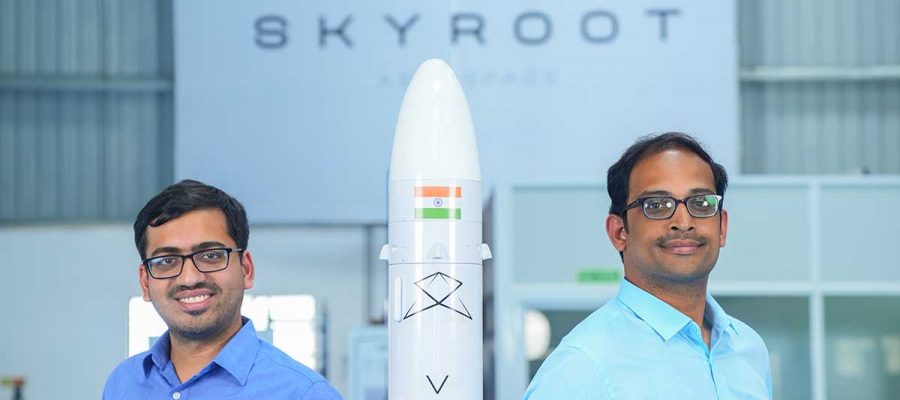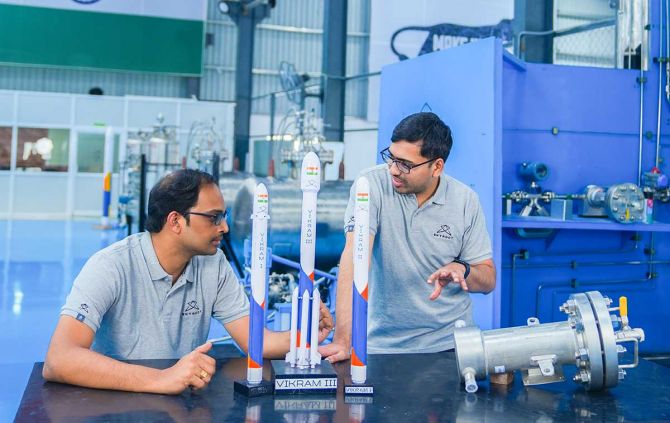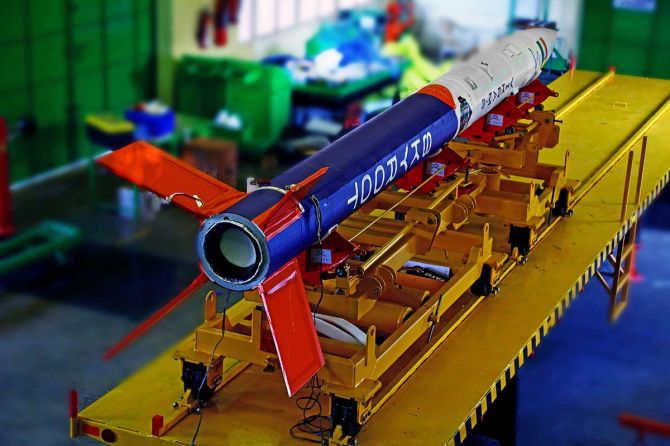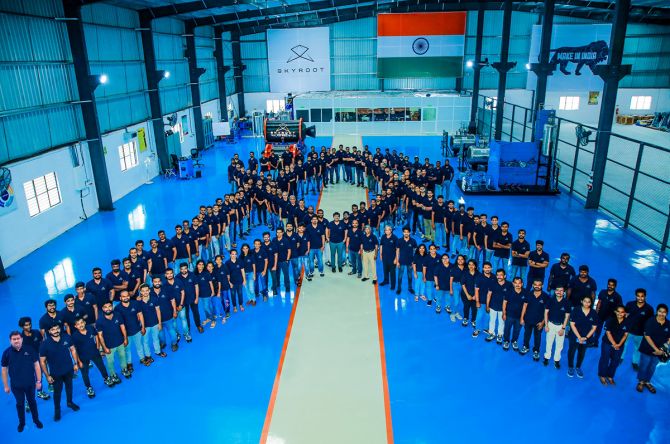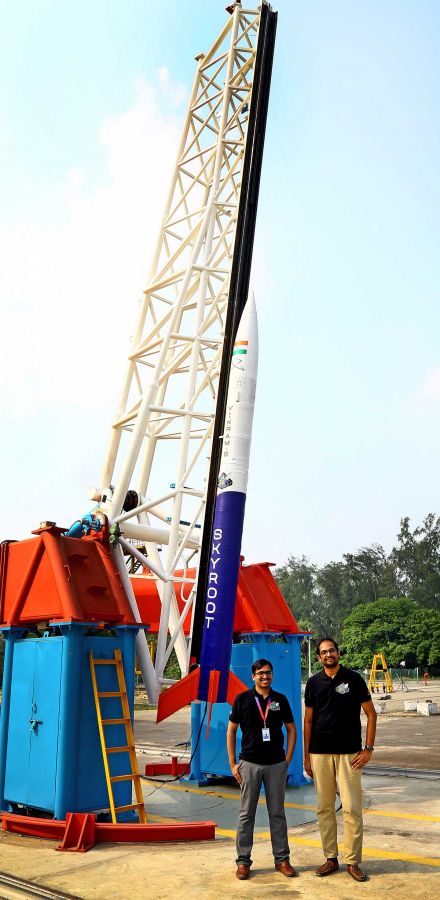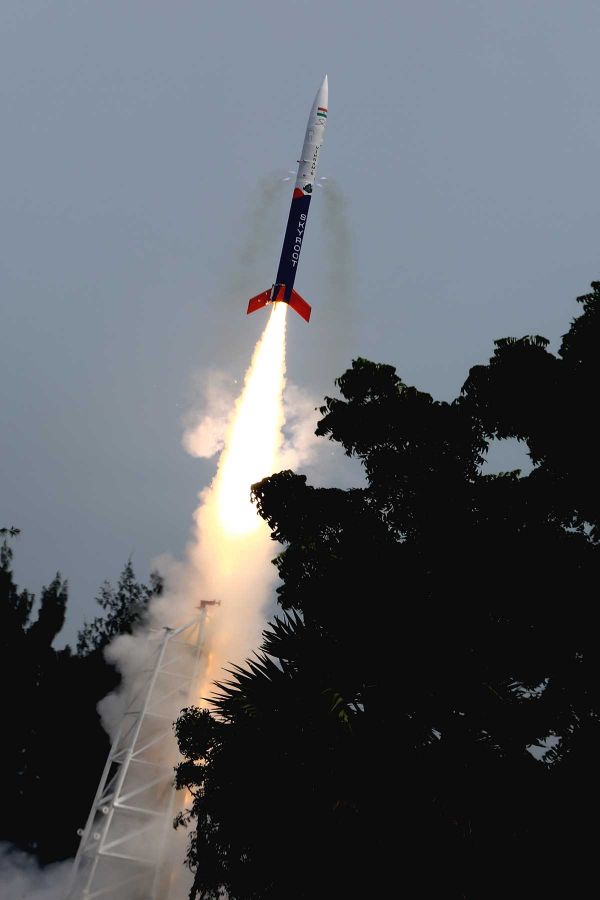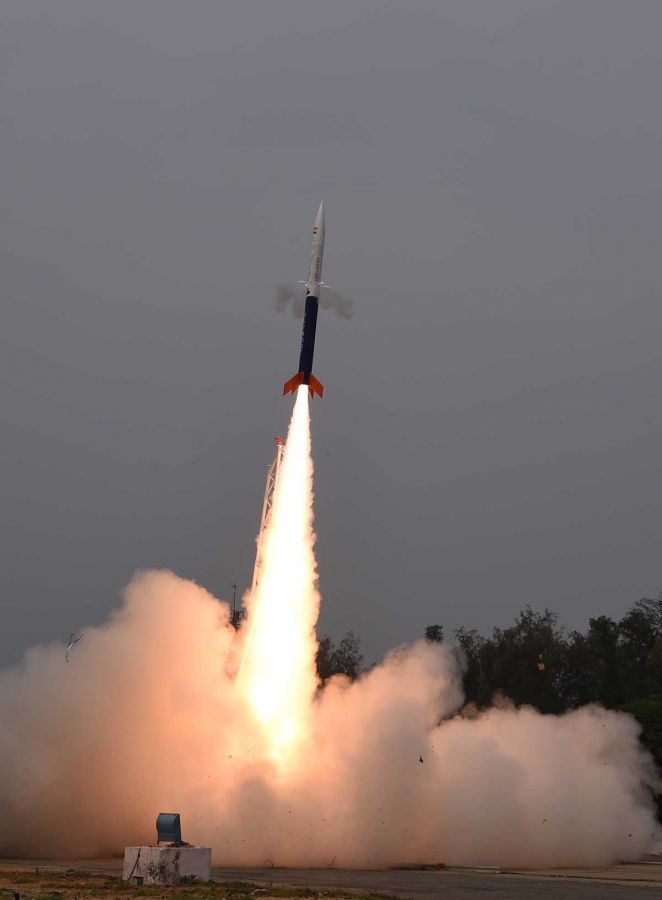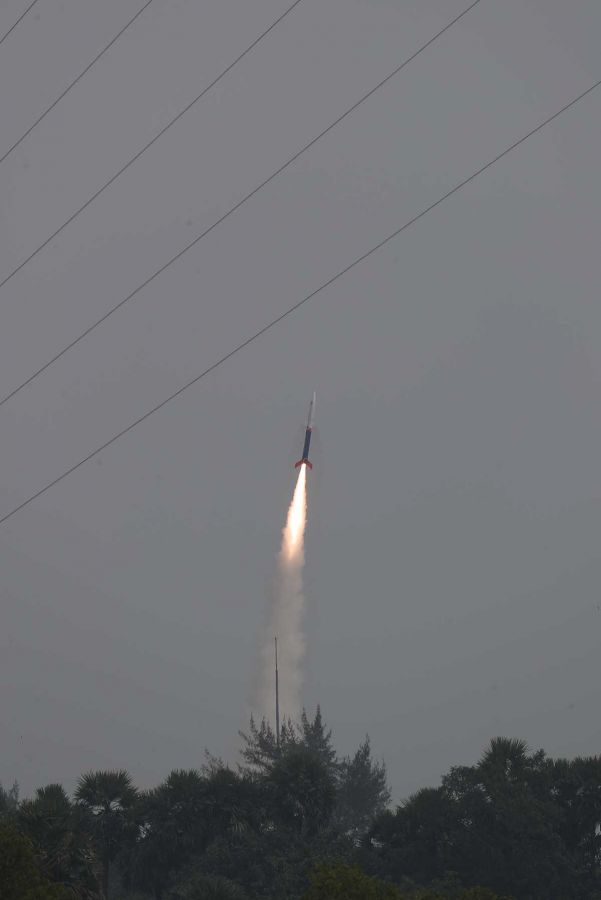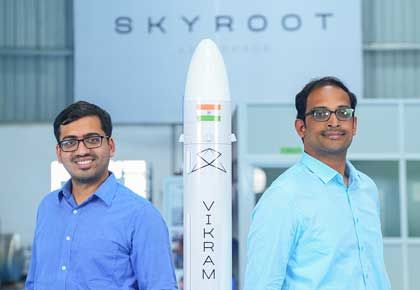‘What we have done is a symbol of new India; that is what a small start-up can do, a few hundreds of people coming together, developing a rocket and launching to space and succeeding at the very first attempt.’
On the 18th of November at 11.30 am, when Vikram-S was launched from ISRO’s Satish Dhawan Space Centre at Sriharikota, history was being created.
For the first time in India’s space history, a privately developed rocket was launched into space.
The team behind the historic moment was Skyroot Aerospace founded by Pawan Kumar Chandana and Naga Bharath Dhaka.
“All our 200 plus engineers are Indian nationals who have studied here, trained here and contributed to this mission,” Pawan Kumar Chandana — a mechanical engineering graduate from IIT-Kharagpur who worked as a scientist at ISRO’s rocket division for six years after his graduation — tells Rediff.com‘s Shobha Warrier in a MUST READ interview.
Would you say your years at ISRO in the rocket design division changed your ambition in life?
Absolutely. The years at ISRO changed my perspective completely. The cutting-edge rocket technology that I was exposed to at ISRO changed my ambition in life.
In fact, it changed me altogether. I would say, it made me a real engineer even though one studied engineering in college and has a couple of degrees.
Did those years help you become an entrepreneur, or navigate you towards rocket design?
From my college days itself, I wanted to be an entrepreneur. In fact, even from childhood, I always wanted to build my own things. So, you can say the dream to be an entrepreneur was there in my mind even before I joined ISRO.
But ISRO gave me the confidence to believe that you can build great things. Above all, I was exposed to rocket technology in a big way.
Finally, it was the coming together of the mindset of an entrepreneur and the exposure at ISRO that made me venture into this field.
Once I sensed this could be an opportunity to build a good business in India, the entrepreneur in me decided to take up the challenge.
Which was tougher for you? Becoming an entrepreneur or becoming an entrepreneur in the field of space?
I would say becoming an entrepreneur in the field of space has been very challenging because we were trying to build rockets, the most complex part in space technology.
Why did you choose the most challenging part in space technology?
When in college, I wanted to be a rocket engineer because for a mechanical engineer, that is the most complex and challenging area.
And rockets are the key to space. Without rockets, you cannot go to space. The biggest challenge is how to build better rockets and better launch vehicles.
Once you solve this problem, it will open up new frontiers in the space sector and even commercialisation of the space sector. And the key to open this frontier is building rockets and launch vehicles.
From where did you draw the courage to do something in an unexplored area?
It was very challenging for me to get into an IIT in 2012, and after my studies getting to work at ISRO.
I think studying at IIT and the experience I got at ISRO shaped me as an engineer, and gave me the confidence that one can do anything if one puts one’s mind to it.
How were the earlier days of Skyroot Aerospace? Was it easier than you had expected to get funding?
No, not at all. We have raised around Rs 526 crores (Rs 5.26 billion) in the last four years, from the time we started in 2018. It is the highest funding raised in the private space sector.
It was very challenging because it was for the first time that somebody was raising such large funding in the space sector.
Each time before we raised funds, we had to talk to many investors, convince them and make them understand the vision. Above all, the vision should match.
It would have been easy if there was precedence. It would be easier for them to take the risk if there was a policy.
When we started out, there was no space policy that said we could launch rockets to space.
Did you get any funding from ISRO’s commercial wing, NSIL (NewSpace India Limited)?
NSIL is different. It is about commercialising ISRO’s technology. It has nothing to do with supporting new start-ups.
Supporting new start-ups and creating new policy and regulation under the new space policy is inaugurated just five months ago.
Under the new policy, the mandate to help is given to the newly formed IN-SPACe (Indian National Space Promotion and Authorisation Centre) which came into existence only 5 months ago.
How tough was it for you to convince your investors?
It was very, very, difficult. We had to speak to several investors across the country. We are glad we finally found investors who had similar vision, who had the confidence and who had the risk appetite to do something of this sort.
All that resulted today in this big celebration of India’s first-ever private rocket launch. Above all, we succeeded in the first attempt.
As entrepreneurs, we have taken a big leap of faith to start a company even though there were several risks involved. As investors, they took big leap of faith in these two people along with a team.
Yes, it was very challenging to find the right investors, but we are very happy we found the right people to back us up.
From designing to finally launching Vikram-S, how was the journey?
It was a phenomenal journey. We started the Vikram-S project only two years ago. Before that, our focus was solely on Vikran-1, the orbital vehicle which we have been developing.
Then, we decided to test more technologies before we launch Vikram-1.
That was how Vikram-S was born two years ago. We thought it would be easier to design Vikram-S but rocket science is rocket science.
It was an extremely, extremely, difficult and challenging journey we have had. We have done hundreds and thousands of simulations to see that the rocket design is perfect. We did a lot of testing to see that we have got it right.
It had been a big learning experience for all of us.
What were the major challenges you had faced?
We have used new cutting-edge technology. The entire rocket is mostly built with carbon fibre structures. It was for the first time in the country that an entire rocket was built with carbon fibre structures in the space sector.
Then, we have used 3D printing which is again a new technology in the space sector.
It is a very big challenge to use cutting edge new technologies like carbon fibre and 3D printing when the industry is not mature enough to build these technologies in the space sector.
When you use new technology for the first time in a very short period of time, it is all the more challenging as there is no precedence and everything has to be perfect to make it happen.
How important is it to have a good team to make it happen?
That is the most important part. A company is nothing but its people. And our team played a major role in making this a success.
All our 200 plus engineers are Indian nationals who have studied here, trained here and contributed to this mission.
India has phenomenal talent, and the success of this launch is the proof that Indian talent can have world class achievements.
Why did you decide to name the project after Vikram Sarabhai?
If you look at the history of India’s space sector, it all began in the 1960s when India was a new nation. There was a lot of poverty, and the economy was struggling. At that time, this man convinced the government to invest in space and launch India’s first rocket in the 1960s.
He had a vision for space and without that vision and initiative, we would not have been here today.
That’s why we wanted to name this Vikram. It is a tribute to a great leader as Vikram-S was possible only because of him.
What we have done is a symbol of new India; that is what a small start-up can do, a few hundreds of people coming together, developing a rocket and launching to space and succeeding at the very first attempt.
This has not happened before and whoever we had told, never believed it also!
But you believed in yourselves…
Yes, we believed in ourselves because we knew it was just a matter of time. We made sure that everything was perfect before we were ready. And we made it happen!
And without any failure.
Yes, without any failure. The mission exceeded expectations. …
What did you feel when it went up without any hitch?
I cannot even describe the feeling in words. It was like years of hard work went into those few seconds of flight. It was just 300 seconds of launch.
In your mind, you were thinking of what all could go wrong. There were many sleepless nights before the launch.
When the countdown started ten, nine, eight… the mind became so silent and we were shivering.
All our hard work had culminated in the launch, and anything could happen… Even after 50 successful launches, the 51st can go wrong, and this was our first launch.
Once it took off and went in the right direction, we started feeling opposite of what we were feeling till then.
In a few milli seconds, the feeling changed to excitement, happiness, and exuberance…
How will your success, the success of a private start-up, going to change the space sector in India?
When I had interviewed Dr Madhavan Nair, he used to say that the advantage India had was low cost in say, launching satellites compared to the US or Europe.
Like Dr Madhavan Nair Sir said, one default advantage India has is cost.
We at Skoot believe that cost alone will not be the driver to be sustainable. Two things have to go hand in hand; one is innovation and the second is cost.
If you want to compete internationally, we need both. That’s why we decided that when we build rockets, we will only use the best cutting-edge technology, that is carbon fibre.
Have you been getting feelers from the rest of the world after the launch?
Oh yes. In the world itself, it is a rare event that a rocket launch succeeds in the first attempt. Very few companies have achieved this.
So, it is a matter of great importance not only for India, but the world as well. In fact, we have opened the space for everybody.
I agree, this is only our first attempt, and there is a long way to go.
Our current focus is on Vikram-1 which we plan to launch next year. That will put satellites into orbit for both India and international customers.
Once we succeed in that, there will be multiple launches every year, and we will increase our capability in production so that we can have more launches.
It is a very competitive field, and the company has to gear up to succeed internationally.
You are being described as India’s Elon Musk. How do you react to the title?
That is definitely an exaggeration as Elon Musk has achieved so much!
Elon Musk is a private player in the space sector and once Vikram-S was launched, it is but natural to have this comparison. But I don’t think it is a right comparison at this point of time. It will unnecessarily put a lot of pressure and expectations on you.
When you know that you have a long way to go, it is better to keep it that way.
Yes, I am inspired by people like Elon Musk and several other great entrepreneurs. In fact, I am a big fanboy of Elon Musk!
Feature Presentation: Ashish Narsale/Rediff.com
Source: Read Full Article
